Semakau 27.6.09
Since this will be my 2nd last Semakau trip until (maybe?) next year as I’m going abroad for further studies and that I’ve to pack my bag later for camp tomorrow, this will be an entry with more photos :)
Warning: Scroll down slowly, read bit by bit. You’ll know why I say so later on.
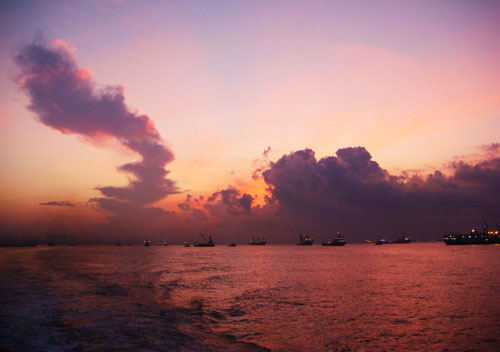
The 4th and last Semakau guided walk of June started off nicely with this scenery in the morning…

Black smoke and ship.
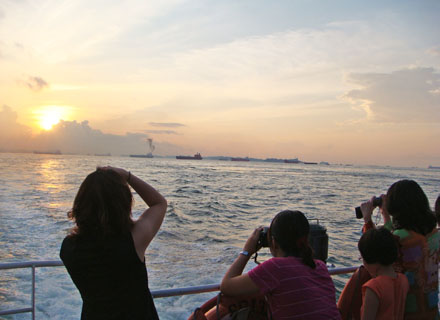
There were quite a number of photography enthusiasts among our participants for this guided walk :)
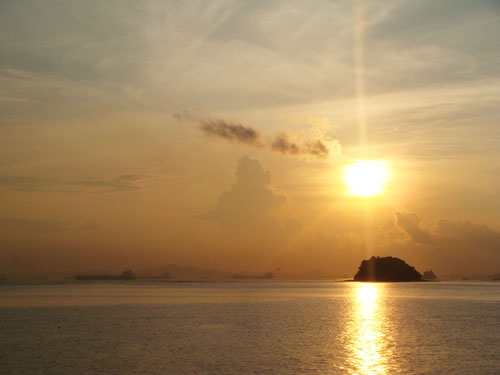
The sun had just risen behind Pulau Jong aka Bao Island, which is close to Pulau Semakau.
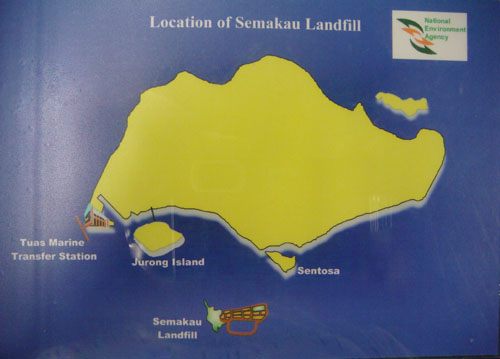
Semakau Landfill is situated in the southern part of Singapore and the boat passes Sentosa en route to Semakau from Marina South Pier.
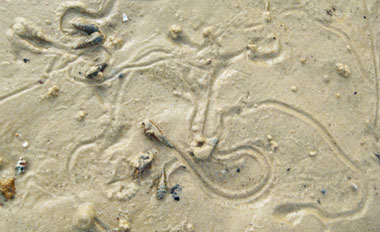
As we walk along the sandy shore, there were many many creeper snails everywhere creating maze-like patterns in the sand. These snails’ feet produce mucus to help them move around.
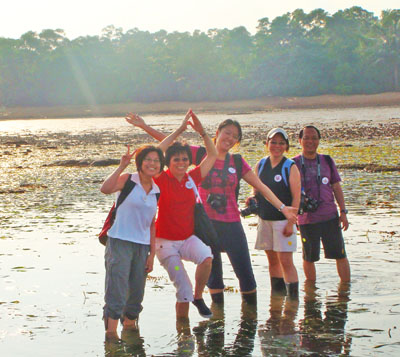
Crossing the seagrass lagoon, the 5 Seahorses with their wacky poses were about to embark on a ‘better than Underwater world’ journey… :P
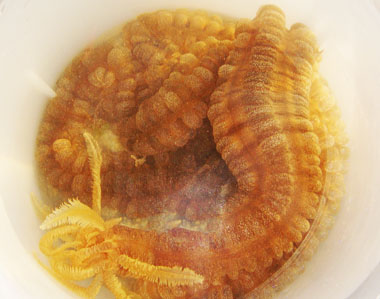
The first sea cucumber found during that day was the synaptid sea cucumber. This sea cucumber is very delicate as it has a thin body wall and is not edible. It uses its feeding tentacles (bottom left corner of photo above) to ‘sweep’ around to collect food.
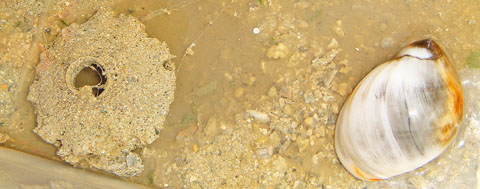
Perhaps, this moon snail (right) had just laid her eggs. The moon snail’s eggs are contained in the sand collar (left) so although it may not look ‘alive and kicking’, there’s actually plenty of tiny snails inside waiting to hatch!

Our hunter-seekers found the lined chromodoris nudibranch (Chromodoris lineolata) . At first, I spotted one lonely soul.

Then came another one in the opposite direction… ! Before you scroll down this page, what do you think they were planning to do? Is it……………

A) Greet and smooch? ♥
or…
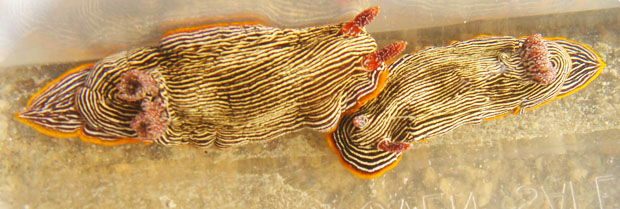
B) Cheek smooch
Answer: They did A then B. hahaha! << highlight for answer
The nudibranch, which refers to naked gills, is a sea slug. They use the flowery-like gills on their backs to breathe. The two rabbit-like ears that you see on the front are rhinophores, which help them to sniff for prey in the waters. Nudibranchs are also colourful, to warn others that they are dangerous and distasteful to eat.
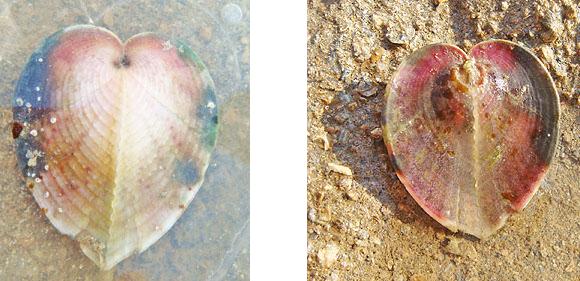
The front (left) convex side and back (right) flat side of the pretty heart cockle. Apparently, the heart cockle is a hermaphrodite which means it has both male and female reproductive organs! Having a pretty shell has its downside… people collect them… alive! It is only when they are alive that both shells stay together but take them out of their habitat and they will die. So what’s the best alternative? Admire them from photographs and leave them at peace.
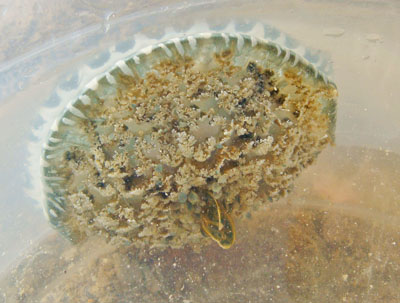
Benefiting from algae is the upside-down jellyfish. The side that you see in this photograph is the bottom side of the jellyfish that is exposed to sunlight. Basically, this upside-down jellyfish harbours symbiotic algae among its tentacles as the latter photosynthesizes and provides food for the former. In return, the symbiotic algae receives shelter and protection.
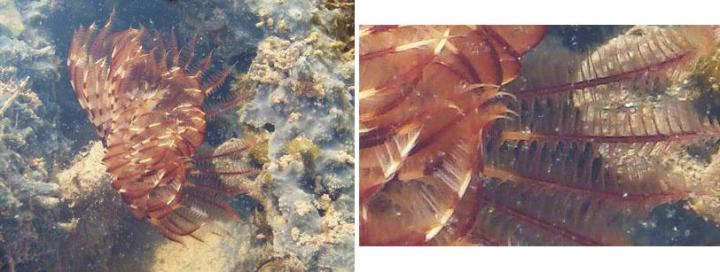
One can spot fan worms in tidal pools as these shy animals spread their pretty fan-like tentacles in the water for filter-feeding. Details of their tentacles can be seen in the photo on the right.
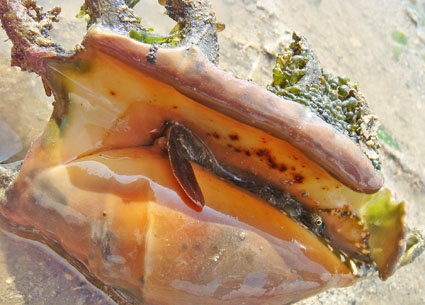
Looking at us precariously was this spider conch, with its long stalk eyes and curved knife-like opercuclum out of its shell. The latter helps the spider conch to ‘hop on the ground and flip itself back to its original position when placed upside down. The spines at the side also aid in stabilisation, thus preventing them from falling over.
This snail is a beauty but vulnerable as people catch them for food and its shell!
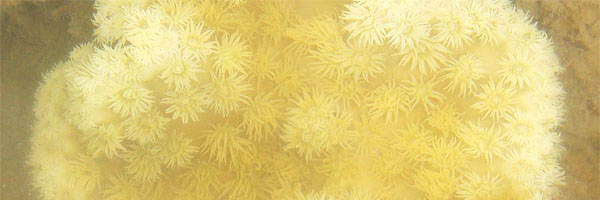
With the tentacles all out in the water, this disk or turban coral (turbinaria peltata <- edit: Thanks Siyang for ID) is a hard coral due to its calcium carbonate structure below.

After the lined Chromodoris nudibranch, we also saw 3 other nudis: (from left to right)
Pustulose phyllid nudibranch, Black-margined glossodoris nudibranch, Black phyllid nudibranch

Beside the nudibranchs that the hunter-seekers found for us was a huge cushion sea star!
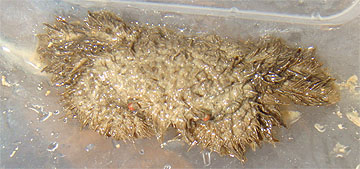
As we headed back to the seagrass lagoon area, we managed to see this hairy crab aka teddy bear crab. It is poisonous and not edible, different from the hairy crab that we get to eat in Chinese restaurants.
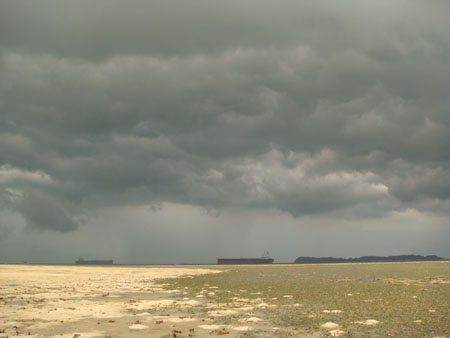
A picture tells a thousand words.
The wind was blowing rather strongly at that time and although I kept praying for good weather as I took this picture, I can’t help but feel this provided some respite from the hot sun earlier on during the walk.
My last Semakau walk this year will be in July. Will I get the chance to do hunter-seeking? *prays*
Haha we’ll see. Otherwise, it will be my last time guiding and giving the landfill tour. *tears*
nostalgia ;)
Semakau 26.6.09
After 2 exploratory trips early in the previous mornings, it was the 3rd day waking up early. Nevertheless, I looked forward to guiding the Stingrays :)
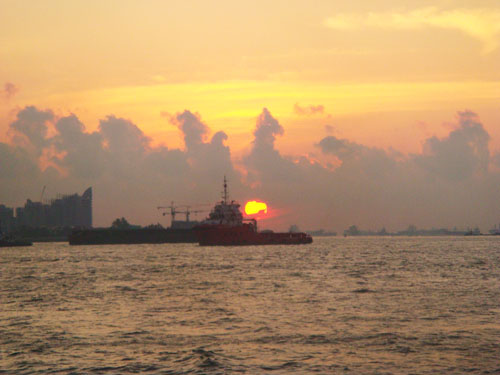
On board the boat, we were greeted by the ever so effervescent yellow sun which never fails to get everyone to take photos.
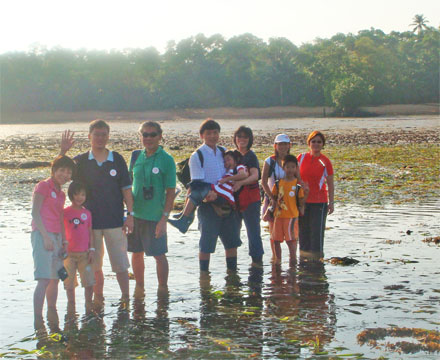
Here are the ‘Stingrays’ crossing the seagrass lagoon, which is an important place for juvenile animals to seek food, shelter and protection from predators. The ‘dead path’ that they cross has been specially designated, so as to minimize damage to the surrounding flora and fauna.

One of the first animals we saw after crossing the seagrass lagoon was the ovum cowrie (Cypraea ovum). The shell of a cowrie is shiny and smooth to touch because the cowrie uses its mantle (part of the body) to enclose the shell. This helps to protect itself from animals and algae. Unfortunately like many snails with pretty shells, they are threatened by collectors.
I strongly discourage shell-collecting as you’re either inadvertently taking the cowrie away from its habitat or a home from the hermit crab!!
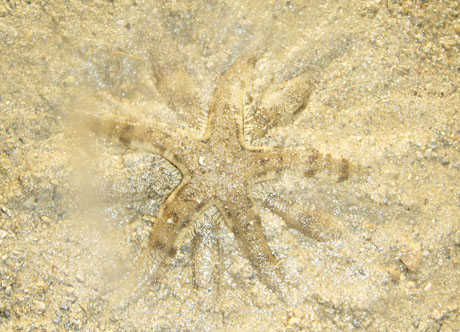
A pair of common sea stars was mating and we can see them alternating their arms. The male which is usually smaller, is on top of the larger female and they release the sperm and eggs simultaneously into the water so that there is a higher chance of pro-creating.
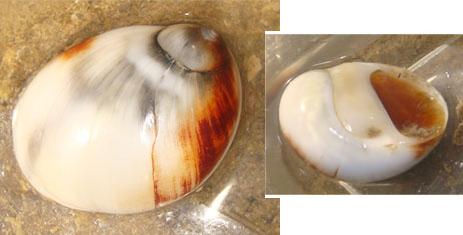
Never judge a book by its cover!
… What I mean of course is this oval moon snail hiding in its shell. The picture on the left shows the top of the shell whereas the one on the right shows the foot of the snail.
Pretty but ferocious, it actually eats other snails! It suffocates the prey with its foot and sometimes before the prey can even come up to breathe, it secretes acid to soften the shell and uses its tongue-like radula to create a hole to feed.
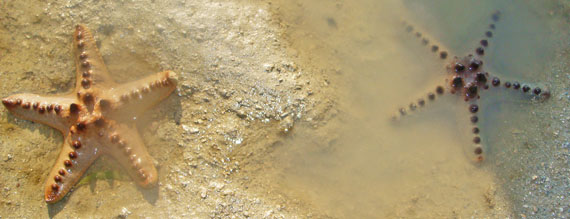
The knobbly sea star aka chocolate chip because the knobs on the body looks like it. These sea stars come in other colours such as red and orange and can grow up to about 30cm. Sea stars require seawater to regulate around their bodies so we should try our best to not take them out of the water for too long.
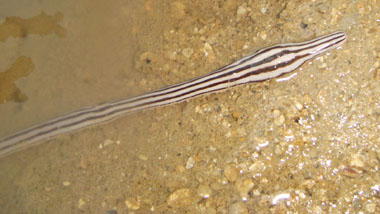
Moving at its own pace, albeit rather slowly is this long ribbon worm. It is venomous and delicate so do not ever touch or handle them!
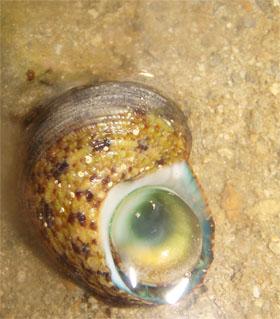
The ‘cat’s eye’ of this sea snail never fails to intrigue me. With its beautiful colour, some coastal communities use them as buttons or to make jewellery. However, this ‘cat’s eye’ acts like a door for the turban shell. This helps to protects itself from predators while the body is retracted into the shell.
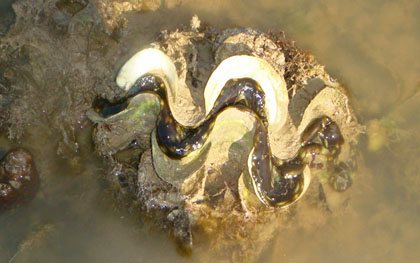
Have you ever watched cartoons and saw clams clipping people’s fingers?!
━━Σ(゜Д゜|||)━━ !! << Japanese emoticon for being shocked
Fear not, for that will not happen. Even at low tide (as seen from the photo above) the shell of this giant fluted clam does not close completely and you can see part of the mantle being exposed. The wavy structure makes it perhaps slippery and difficult for predators to climb in, thus deterring them to feed on the flesh of the clam.
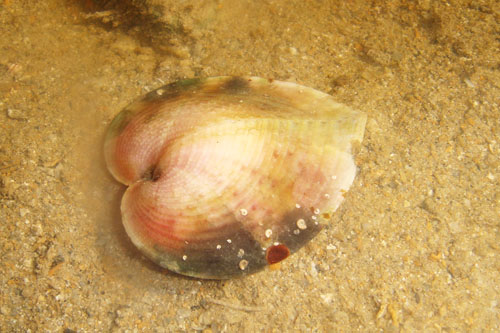
It was a pleasant surprise to see this slightly pinkish heart cockle. The shell opens from ‘the centre of the heart’ and you are looking at the convex side in this photo.
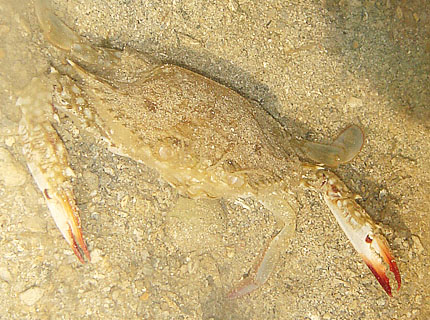
The Stingrays also got to see the moult of the flower crab. The sharp pincers help the crab to hunt for prey and defend itself when it senses danger. And yes… you can cook and eat a flower crab. Our local zi char stalls should have them.
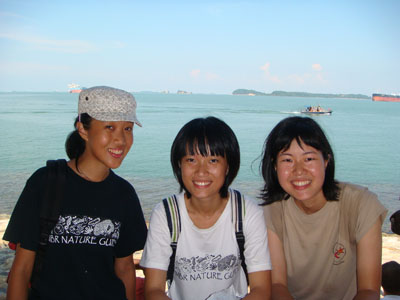
I took a photo with fellow Semakau guides :D – Kim and Meiyi – at the southern tip of Singapore that the public can access. In the background of the photo above, you may be able to spot these 2 islands (below).
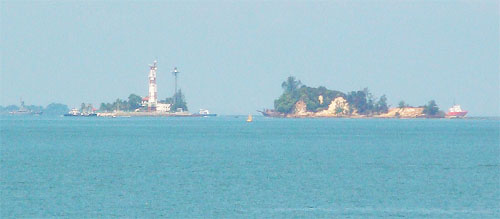
Raffles lighthouse on the left and Pulau Viola (or violin) on the right. The southern-most point of Singapore, Raffles lighthouse… I’ve always wanted to go there for an exploratory trip. Hopefully my dream can come true next month! :)
Semakau 12.6.09
Last Friday, we had a guided walk at Semakau and I guided the Great Billed Herons for a second time!
Aside from being the tallest bird in Singapore, the great billed heron is also a rare bird here. In fact, a nickname has been given to this resident on Pulau Semakau… Jimmy! Jimmy is a resident breeder, which means it is present throughout the year.
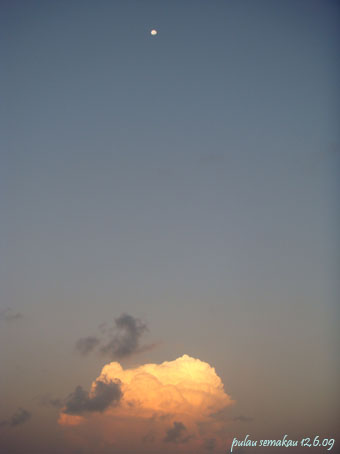
And the day starts with… there you go… both sun and moon! The sunlight reflected in the clouds :P
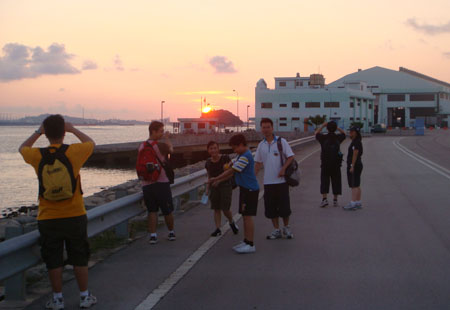
Herons taking photo of the sunrise peeking behind Pulau Jong in the distance.
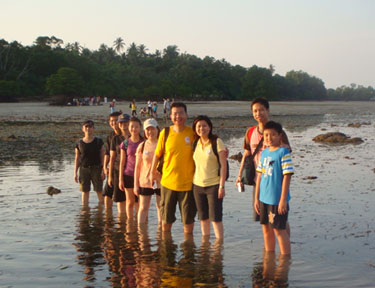
Now for a group shot of the Herons while crossing the seagreass lagoon, basking in the morning sun!
The seagrass lagoon is an important place because many juvenile animals seek both shelter and food down there. They can also hide from predators amongst the seagrass.
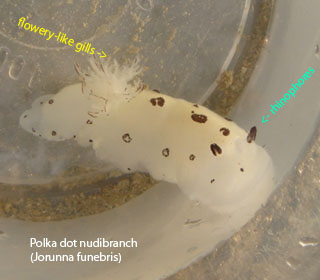
The Herons got to see the polka dot nudibranch on that day!
Nudibranchs are sea slugs and from the photo above, it’s the flowery-like gills that are the naked gills which the nudibranchs use to breathe.
Just like how nudibranch refers to naked gills, rhinophores come from two Greek words. Rhino = nose, phore = carrier.
The rhinophores are situated at the front end and act as scent receptors, meaning the nudibranch uses them to sniff for food in the seawater.
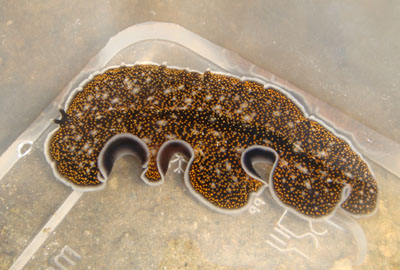
The spotted black flatworm, flapping its body in the water in order to move/swim around. Flatworms are hermaphrodites, having both male and female reproductive organs! It is usually more energy-consuming to be the pregnant female so they ‘fight’ to inject sperm into the other party.
Interesting read! >> “It is better to stab than to be stabbed… … “
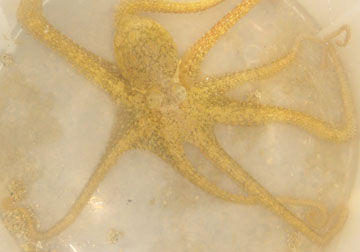
Tako たこ Tako たこ
Have you guessed what’s tako? It is octopus in Japanese. The 8-arm master of camouflage. It is also a predator that is able to squeeze through very tiny spaces. The octopus has a well-developed brain and a very good memory. Perhaps, the intelligence of octopuses are as intriguing as that of dolphins.
Humans can be either left or right-handed. Do octopuses have a preference for using one side of the brain? You can check this article out. It is a pretty long article but will let you gain a deeper insight into the intelligence of the octopus.
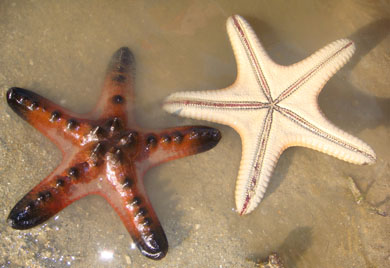
Knobbly sea star aka ‘chocolate chip’ sea star. They can grow up to about 30cm and I’ve seen them in colours such as red, brown, orange!
A fellow guide told me that she once saw these sea stars sold in a shopping mall’s aquarium store and they were not in ‘good condition’, barely surviving in the tank. My heart aches for these knobblys. In the red list of threatened animals of Singapore, knobbly sea stars are being listed as endangered creatures.
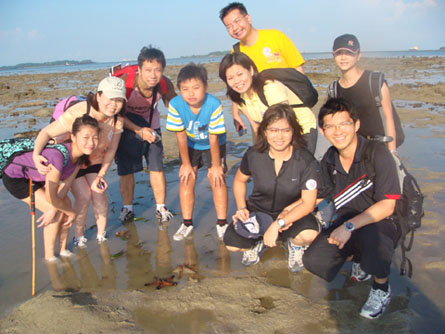
The Herons taking a group photo with the two knobbly sea stars. We try our best not to take them out of the water for too long as sea stars use seawater to regulate around their bodies, just like humans have blood.

There was also the seahorse, where male seahorses ‘help to share the burden’. The female seahorses deposit the eggs into the pouch of the male seahorses, thus making the male seahorse look ‘pregnant’. In TCM (traditional chinese medicine), the seahorse is considered as an aphrodisiac, which is a sexual stimulant. However, I would recommend someone taking aphrodisiacs to consider ginseng (a herb) as an alternative. Haha.
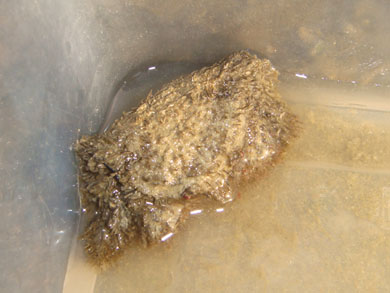
The hairy crab was spotted by the Herons quite a few times. The name suggests that there’s hair on the body of the crab, which helps to trap sand and sediments, thus helping it to blend in with the surroundings. It is also called ‘teddy bear’ crab due to its fluffy appearance.
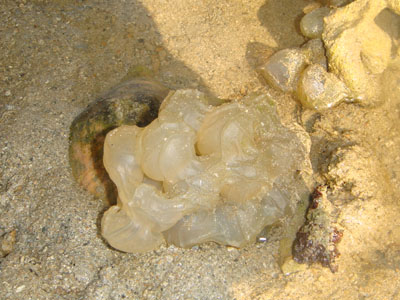
On the way back, we also saw a noble volute (sea snail) laying its eggs! The pretty shell is hidden by the eggs in this photo, which is collected by people due to the beautiful patterns on the shell. Please refrain from collecting shells!! Each shell you take, you are taking a home away from an animal, such as the hermit crab.

Last but not least, we saw a turban snail. When placed upright, the shell resembles a turban, hence the name. Its ‘cat’s eye’ or operculum, is like a door to the home. Some coastal communities use the ‘cat’s eye’ to make buttons or jewellery. The turban snail also feeds on algae and scraps them off the rocks.
It was a first time intertidal walk for many of the Herons and there was even one repeat participant who came for our walks before. That’s great! There will be more walks next week and I hope the participants will also get to enjoy the beauty and biodiversity of Semakau! :)
Semakau 11.6.09
It was nice to be back at Semakau again. The walk was held early in the morning due to the low tide. We had 7 Secondary 3 students from PLMGS forming the Horseshoe crab group.
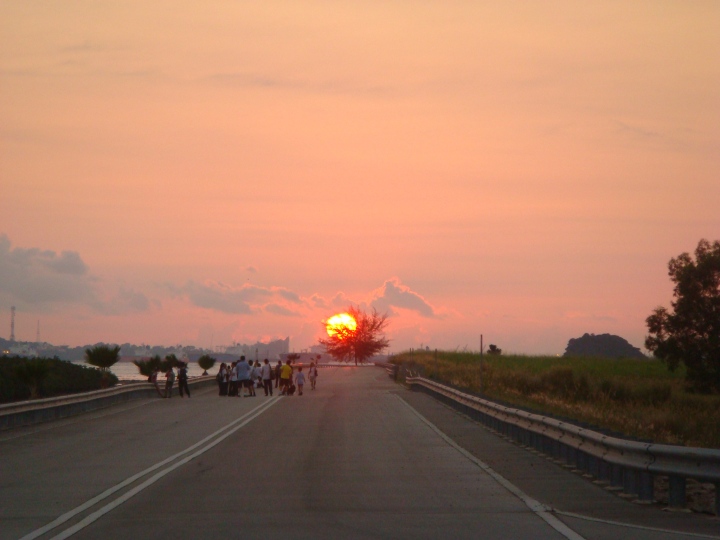
While walking on the long stretch of road to the intertidal area, we were awed by the beautiful sunrise in the distance. It reminded me of a ball of fire burning before my eyes, definitely not something you usually get to see on mainland Singapore… and also made me feel more attached to Pulau Semakau.
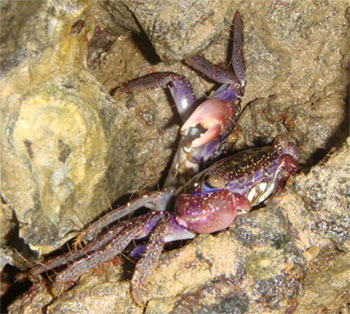
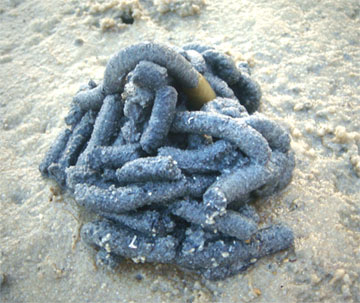
Left: We had just started the intertidal walk and saw this pair of purple climber crabs peeping at us (where the oysters were). These small crabs have a flat body, usually with a width of up to 4cm and feed on algae. However, they also can be scavengers which like to hide in the crevices of rocks during the day. Were we the paparazzi, disturbing them while they were (perhaps) mating? Let’s hope not :P
Right: This pile of ‘shit-like’ matter appears to be the works of the acorn worm. It is currently in the process of feeding and if you look amongst the canvas of grey, you can spot the yellow body which is the acorn worm. They burrow, swallow and feed on particles in the sand. After which, the sand is excreted at the other end, forming coils on the surface. We should never attempt to dig them out as they are delicate creatures which should be left alone while feeding. :)
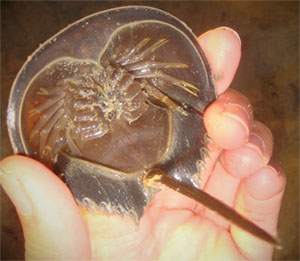
At the mangrove area, a mangrove horseshoe crab was found! This photo shows the underside of the animal.
As it does not have jaws, it grinds its food while it walks as these movements help the ‘broken food bits’ to flow into the mouth. In some countries, the eggs of the horseshoe crab are considered a delicacy but they are poisonous and there were reported cases of people who died from eating them.
They are not true crabs, but instead are cold-blooded creatures which have been around even before the dinosaurs and are also closely related to eg. scorpions and spiders. Did you know that the blood of horseshoe crabs is blue? You can read about the unique properties of their blood at: The horseshoe crab – A true blue blood
How should one tell the differences between the coastal and mangrove horseshoe crabs? One way is to look at the cross-section of the horseshoe crab’s tail (they are not weapons but used merely to right themselves if turned upside down). The usually larger coastal one looks triangular while the mangrove one looks rounded. However, this may not be accurate when they are juveniles. So one can tell by gently stroking the tail for its texture. The coastal one feels a little ‘bumpy’ while the mangrove horseshoe crab’s tail is smooth.
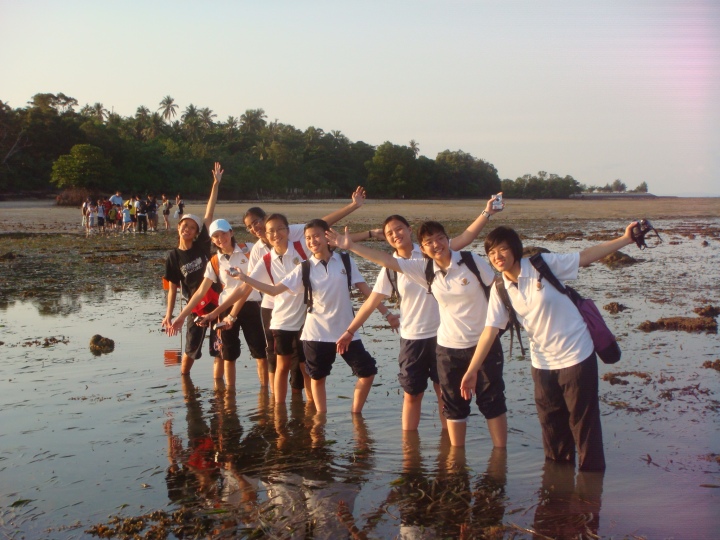
Group photo of the horseshoe crabies and Kim crossing the seagrass patch :)
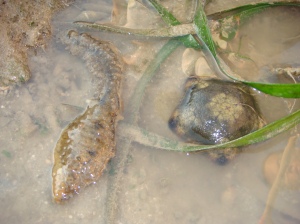
The hunter-seekers helped us to find a dragonfish sea cucumber (left) and a cushion sea star (right) near the seagrass lagoon. It was the third type of sea star we saw besides the common sea star and knobbly sea star.
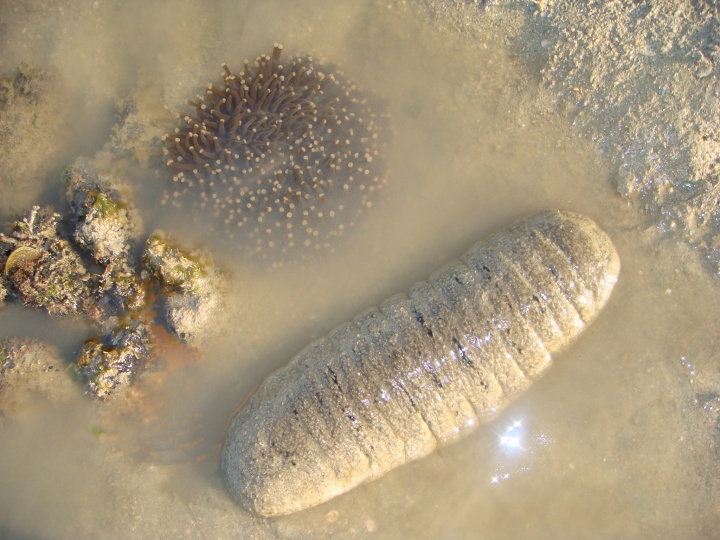
Mmm… feelin’ a little hungry down there? Do you see garlic bread in this picture? ;)
The animal on the right side of the photo resembles garlic bread and you’re in treat if you like eating hai sheng or sea cucumber during Chinese New Year!
The sea cucumber that can be edible, particularly the sandfish sea cucumber, is actually poisonous. *Gasp!*
No worries, the ones you have on the table have already been processed to remove the toxins before they can be cooked and ready for consumption.
Parallel to the sandfish sea cucumber is a sunflower mushroom coral.
Hard corals have many polyps (one polyp = one animal) in them, hence many tiny little animals in a hard coral. However unlike other hard corals, this sunflower mushroom coral is a single animal as it has only one (albeit large) polyp with many tentacles, giving it a sunflower-like appearance. As for why it looks like a mushroom, observation has it that when it is a juvenile, it attaches to the substrate (read: surface that a creature grows or is attached to) on a stalk-like structure. However, it detaches itself from the stalk when mature.

…… Are you imagining this? :)
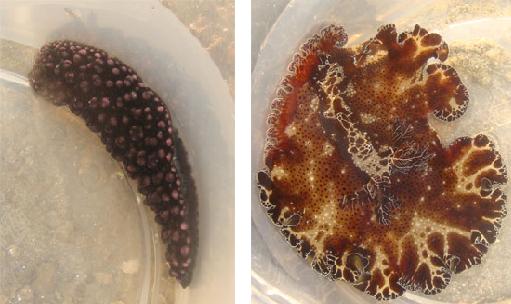
We saw not only one but two nudibranchs!
Left: Black phyllid nudibranch aka Phyllidiella nigra Right: Bohol nudibranch aka Discodoris boholiensis
Nudibranch refers to naked gills, the flowery-like gills on the body, which help the sea slug to breathe. If you look closely, you can see the external gills on the nudibranch in the right photo. The black phyllid nudibranch on the left is different in the case where it does not have external gills and has bumps all over its body.
They can be colourful and these colours warn predators that they are not to the trifled with! They are also able to release toxic chemicals if threatened or stressed. Perhaps not as colourful compared to other types of nudibranchs, the two nudibranchs (above) are of these colours possibly to blend in with the surroundings and camouflage so that predators can’t find them easily.
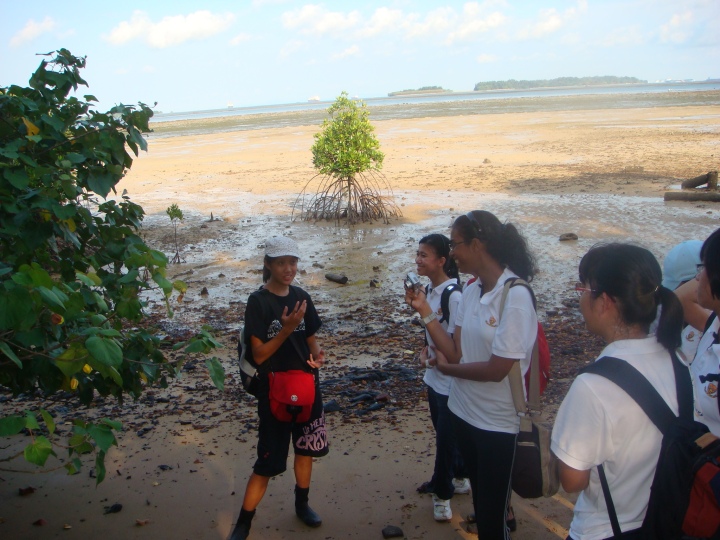
Kim was guiding with me on that day and I must say it is refreshing to not guide alone. haha and we learned things from each other as well.
It has been quite some time since I guided a student group and definitely had fun guiding them for this intertidal walk and landfill tour. ^^
Semakau 31.5.09
Sorry for the late post!
It was the first time I guided a group where everyone knew each other :)
Majority of the 9 participants used to be from a local university’s canoeing club.
The sea is beautiful, but even more so with the marine creatures that all got to see during the intertidal walk!
The group that I guided this time was the Great billed heron, which is the tallest bird in Singapore and one can spot them in coastal areas… sometimes hunting for fishes in the shallow waters. Unfortunately, we did not get to see it in Semakau on that day. If you wish to read about how this bird hunts, you can check this out.
While crossing the seagrass meadow, I took a photo of the participants (one of them thought I was calling them ‘parents’! haha).
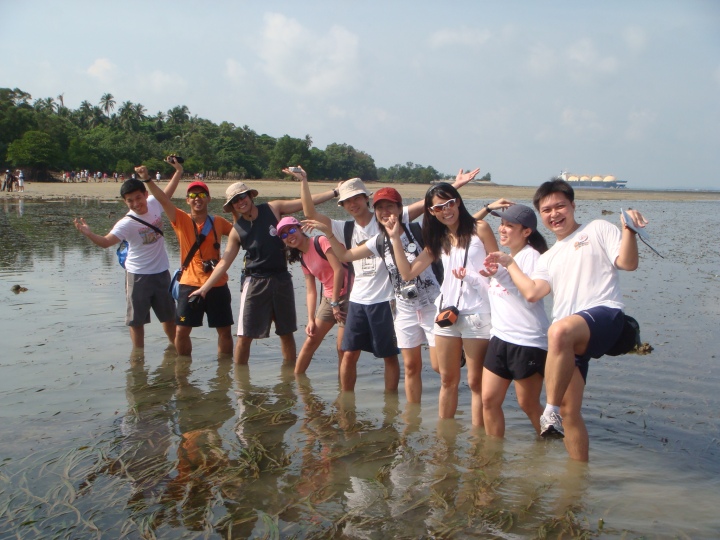
Group posing as great billed herons :D
Before proceeding to the second flag that the hunter-seekers placed, we chanced upon this tiny little swimming crab. It had a distinctive black mark in the centre of its shell. I’ve not seen this swimming crab before and can’t seem to identify it. Does anyone happen to know what this crab is? :picture below (sorry about the photo quality)
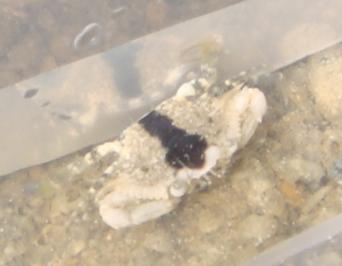
We saw this pretty blue-lined flatworm!
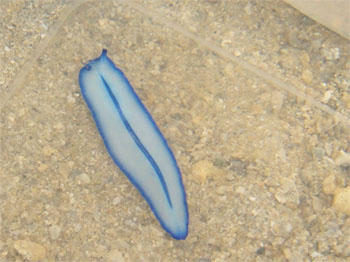
Sometimes, people mistake flatworms for nudibranchs (sea slugs). We can tell flatworms apart from the nudibranchs because flatworms do not have external flowery gills. The flatworm is yes, very flat so it can squeeze through tiny crevices to hide from predators and also to search for food, such as shrimps. While the flatworm has the ability to regenerate when it is torn into pieces, we should never attempt to pick them up as they are very delicate :)
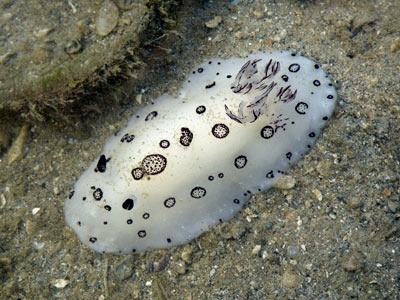 Photo credit: Ron
Photo credit: Ron
Can you see the flowery gills amongst the ‘sea of black and white’? It is one of the pointers that tell us that it is a nudibranch and in this case, the polka-dot nudibranch. Nudibranch refers to ‘naked gills’ and if you look closely, you can see two little black tentacles on top of the head. They are called rhinophores and help the nudibranch to sniff and search for prey. With such fanciful or even colourful bodies, they warn other creatures that they are dangerous and should not be fooled around with. In order to protect itself, some nudibranchs can produce toxic chemicals to prevent predators from coming near.
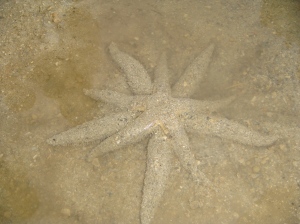
Out of the common sea stars in the sand, we managed to catch one pair in action… mating of course. The male sea star is usually the smaller one and on top of the female. The pair alternate their arms and practise external fertilisation, where they release eggs and sperm simultaneously into the water to increase chances of fertilisation. While the name suggests that they are common… well, they are not as common as before. The loss of habitat due to eg. reclamation projects and pollution, together with over-collection by enthusiasts are perhaps reasons why this could be happening.
You could say we were kinda ‘starry-eyed’ on that day. We saw about 6 knobbly sea stars (including the 6-arm knobbly below!) aside from the common sea stars and 2 cushion sea stars.
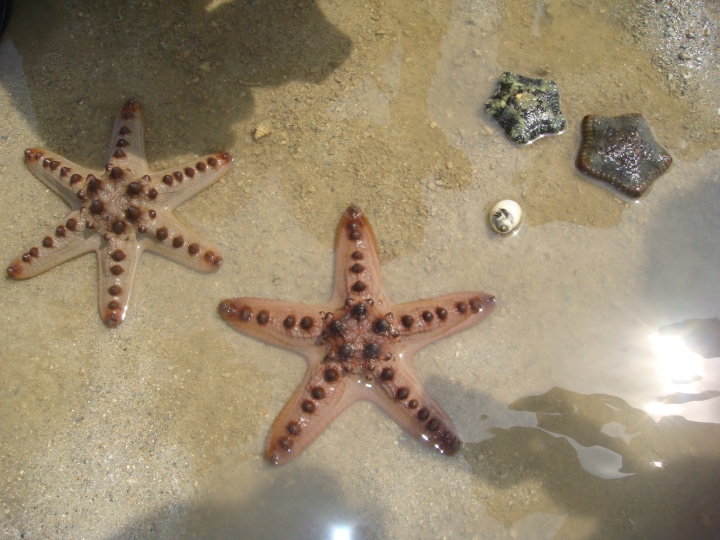
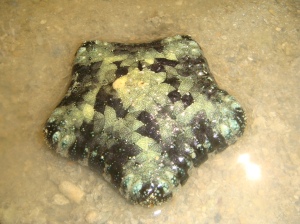
A close-up of one of the cushion sea star. This pattern is really pretty!
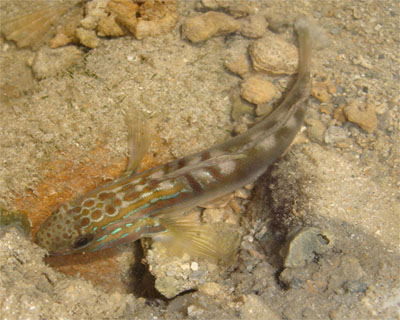
One of the sharp-eyed participants also spotted this head-stripe goby fish. It is probably more colourful compared to the other medium-sized goby fishes found in the shallow waters.
The last walk of the month and am looking forward to some more walks in June :)
Semakau 1.5.09
We all felt lucky on Labour Day.
First of all, we saw wild pink dolphins during the boat ride to Pulau Semakau.
“I’d thought I can only see them captive in Sentosa’s Underwater World!”… or so you thought. Yes but of course, they also swim in Singapore waters and this is my second time seeing them! Everyone got all jittery and excited! You can see people snapping away on their cameras. My camera was unable to capture the dolphins in action so I’ve no photographs but you can check out Ron’s blog entry, which has some decent photos and even a video!
What a great way to start the day, along with fine sunny weather :) The group that I guided this time was: Seahorse!
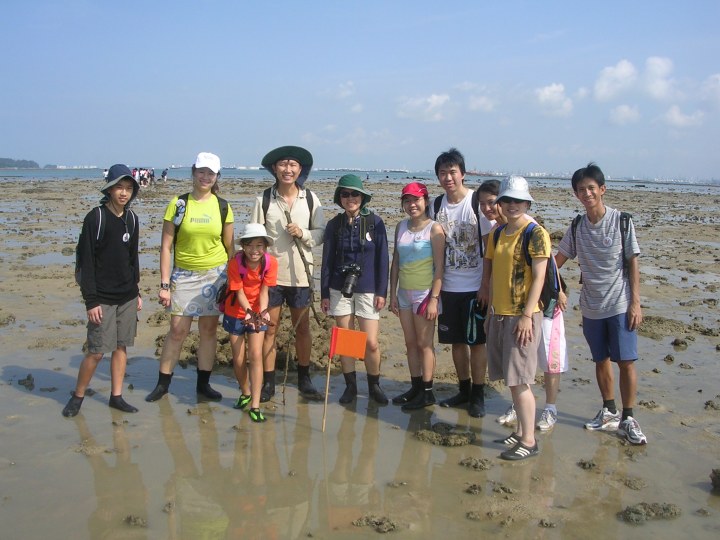 Photo: A very quick shot with juvenile knobbly seastar
Photo: A very quick shot with juvenile knobbly seastar
Seawater to the seastar is just like blood is to humans, they pump it to their body and use their tube feet to move around and burrow into the sand. So it is very important not to take them out of the water for long. Knobbly seastars can also come in different colours such as red, orange and brown. :)
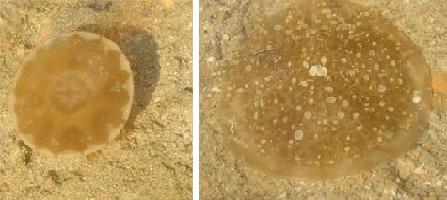
We also saw about 3 to 4 upside jellyfish on that day. The photo on the right is what you would see when you first spot it. On the tentacles of the jellyfish are symbiotic algae, where food made by the latter goes to the jellyfish. And in order to photosynthesize better, the jellyfish stays upside down to get sun exposure! Hence it’s name: upside down jellyfish. The photo on the left shows the jellyfish not in an upside down position.
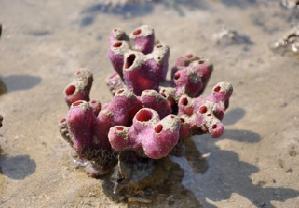
Sponges are aplenty as we walk and we spotted them in various colours, such as purplish-pink (photo above), orange, brown, black etc. In case you thought sponges are plants, they are actually simple animals that constantly pump water through their bodies. Hence there’s the so-called free supply of ‘aircon’ for the animals that live inside the sponges. However, it is advised not to touch the sponges as they can contain toxic chemicals.
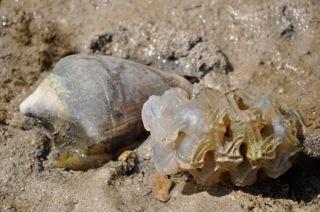
This noble volute had just finished laying eggs and the egg capsules are on the right side of the photo. The noble volute is a sea snail that is currently threatened due to people collecting it for its pretty shell or for food.
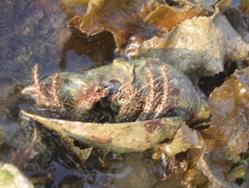
Do you know that when you take away a shell, you are taking a home from an animal such as the hermit crab? As a hermit crab grows it needs a bigger ‘house’, just like how we outgrow our baby clothes. The photo above was taken during one of the exploratory trips to Semakau last year. Similarly, even though a noble volute may be dead and the shell is empty, you will never know when a hermit crab may take over it.
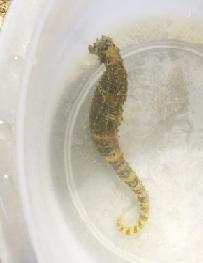
What’s more pleasant than to see your ‘own kind’? The Seahorses managed to see the hero-in-action on that day! Mothers will know the pain one has to go through during child birth. For the seahorses, the ‘burden’ is shared with the father. The female deposits the eggs into the pouch of the male where they become fertilised, thus making the male seahorse ‘pregnant’.
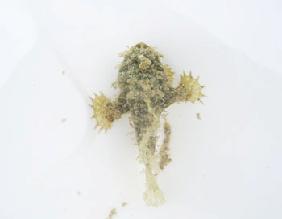
On our way back, we found this tiny frogfish. It doesn’t look like the black frogfish to me, so I think it is the spotted-tail frogfish.
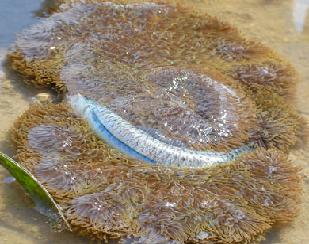
We were also lucky to see the carpet anemone devouring its meal: a fish! Right time, right place. The carpet anemone has stinging tentacles which paralyses the prey, as seen above. One fish that does not get stung by the tentacles is the clownfish, due to the layer of mucus over its body. However, we did not get to see any clownfish on that day.
A list of what we saw in alphabetical order (from what I can remember):
C: creeper snails, common seastar, carpet anemone
F: fanworm, fiddler crab, frog fish
G: giant fluted clam
H: hairy crab, hermit crab, hard corals, heart cockle
K: knobbly seastar
M: mangroves
N: nudibranch, noble volute
O: ocellated sea cucumber, oysters
S: synaptid sea cucumber, soft corals, swimming crab, spider conch, scallop, seagrass, seaweed, seahorse, sponge
U: upside down jellyfish
It was also my first time giving the landfill tour on that day. I was pretty nervous about it but thank goodness it did not go array and my senior, July was there (in case anything happened :P). Well, if you count the impromptu one LK asked me to do last year (I think), this should be my second attempt, albeit a prepared one.
Overall, it was a good day and it was nice to see the dolphins again! :)
—————–
* Photo credits:
Carpet anemone devouring fish – Mel
Sponge and noble volute – Cynthia
The participants sent me the nice pics while I took the rest until my 6-year old Nikon camera died because it touched water. Looking forward to getting a new camera!
leave a comment